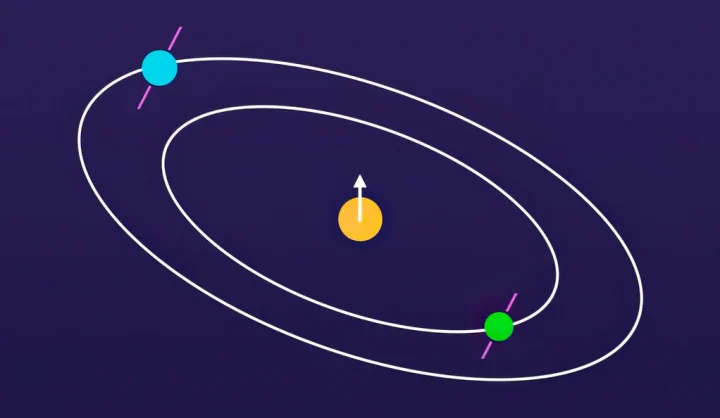Understanding that even planets in pristine solar systems have some orbital tilt puts Earth’s solar system into a larger perspective, researchers say.
Scientists have long puzzled over why all planets in Earth’s solar system have slightly slanted orbits around the sun. But a new, Yale-led study suggests this phenomenon may not be so unusual. Even in “pristine” solar systems, planets exhibit a bit of a tilt.

In this diagram, two orbiting planets exhibit a slight tilt compared to the spin axis of their host sun. Image credit: Malena Rice, Yale University
Astronomers had long assumed that planets with pitchy, angled orbits — orbits that don’t align with the spin axis of their host sun — are the result of some high-level cosmic hubbub, such as nearby stars and planets pushing around their neighbors.
But a new study published in The Astronomical Journal indicates otherwise.
For the study, an international research team led by Yale astronomer Malena Rice conducted a comprehensive analysis of pristine, multi-planet solar systems, where the orbits of planets have remained relatively undisturbed since their formation.
“This type of configuration, where one planet’s orbit is precisely ordered with another in an exact integer ratio of orbital periods, is likely common to find in a solar system early in its development,” said Rice, an assistant professor of astronomy in Yale’s Faculty of Arts and Sciences and lead author the study.
“It’s a gorgeous configuration — but only a small percentage of systems retain it,” she said.
And even in these solar systems, Rice and her co-authors found, planets can have an orbital tilt of up to 20 degrees.
The researchers began their work by measuring the slanty orbit of TOI-2202 b, a “warm Jupiter” planet in a pristine solar system. A warm Jupiter is a planet much larger than Earth with a significantly shorter orbital period than Earth’s 365 days.
The researchers compared TOI-2202 b’s orbit with orbit data from the full census of similar planets found in the NASA Exoplanet Archive. Put in this larger context, there was a typical tilt of as much as 20 degrees for such planets, with TOI-2202 b’s system being one of the most strongly tilted such systems.
Rice said the discovery provides valuable information about early solar system development — and says something important about Earth’s system: that a little bit of tilting is par for the cosmic course.
“It’s reassuring,” Rice said. “It tells us that we’re not a super-weird solar system. This is really like looking at ourselves in a funhouse mirror and seeing how we fit into the bigger picture of the universe.”
The new study also aids Rice in her research quest to understand “hot” Jupiter solar systems, which are systems that contain gas giant planets that may be similar to Jupiter, but with very short orbital periods.
“I’m trying to figure out why systems with hot Jupiters have such extremely tilted orbits,” Rice said. “When did they get tilted? Can they just be born that way? To find that out, I first need to find out what types of systems are not so dramatically tilted.”
Source: Yale University

